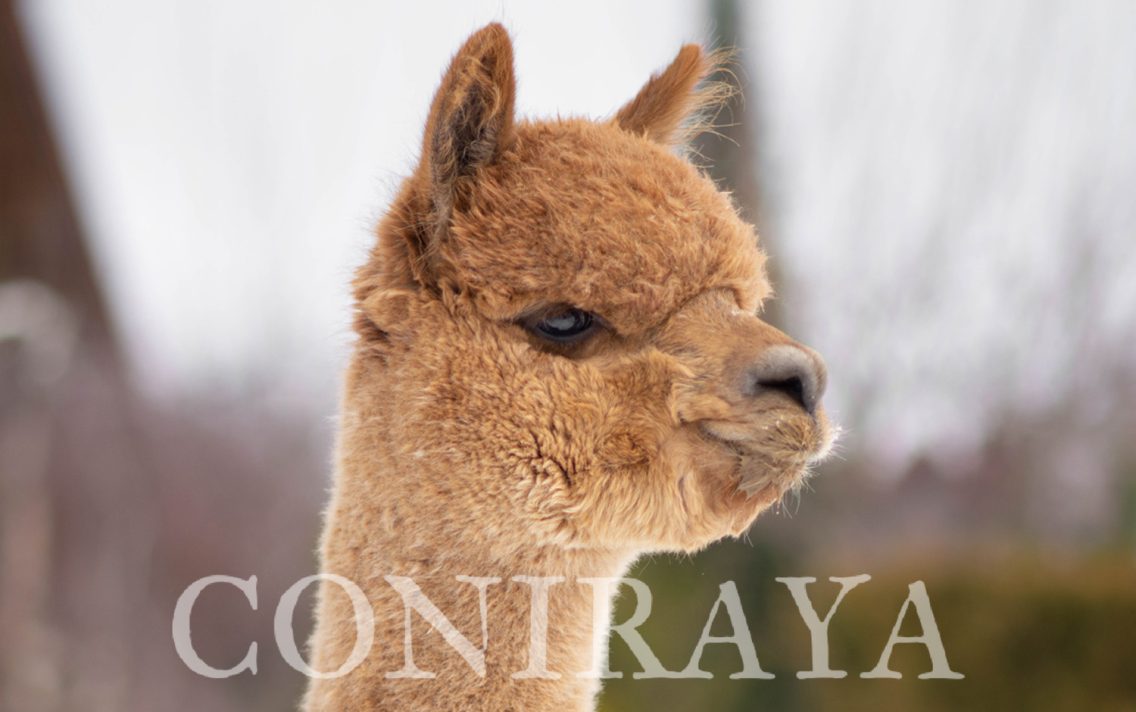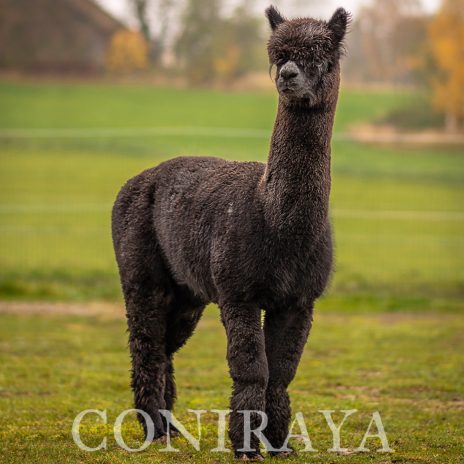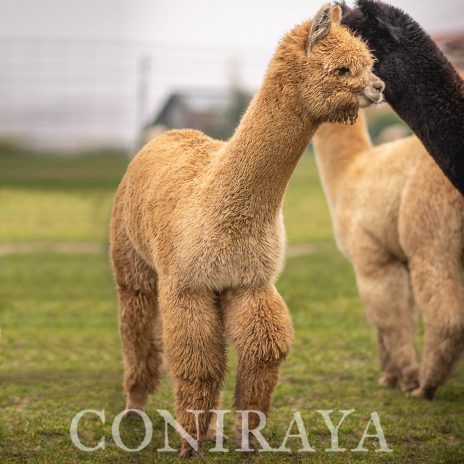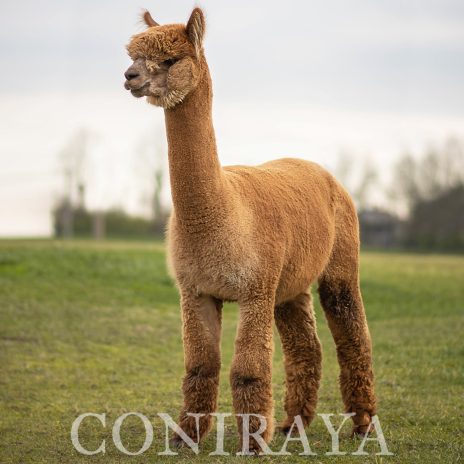Part II. Breeding and feeding
Monika Krajewska-Wędzina, Joanna Najbar, Pamela Turcewicz, Agata Raczyńska
According to archaeological sources, alpacas were domesticated around 4000–5000 BC in the Peruvian-Bolivian Altiplano. Alpacas are bred in the Andes in the area from southern Peru, Chile to northern Bolivia. Today, alpacas can be found in various regions of the world. They have been bred in Poland for over a decade and it is estimated that the Polish population of alpacas already numbers over 3,000. In 2012, the Polish Association of Alpaca Breeders was established, and in 2018, the Association of Alpaca and Llama Breeders.
Alpaca breeding
Alpaca farming most often involves the use of year-round livestock buildings and shelters that protect the animals from unfavourable weather conditions while they are outside. Alpacas can be kept indoors on a straw-lined floor, but they also like concrete floors, which work well in sheds on many good farms. This makes it easier to keep clean because the alpacas wear down their claws better, the fleece is not as dirty, and they can cool off a bit in the spring and fall seasons. In winter temperatures, it is good to put bedding on the concrete. However, a serious breeding farm should have professional infrastructure, such as good ventilation, which will prevent the wool from getting damp. In addition, avoiding moisture helps prevent dermatological problems. The area of livestock buildings should be divided into pens, suitable for different production groups:
1) nursing females with cria (newborns),
2) weaning (preferably separate males and females) after six months of age,
3) mature males (mating with younger ones is not recommended for safety reasons),
4) non-lactating females,
5) neutered males, and eventually
6) a maternity ward so that the female can be separated from the newborn if necessary,
7) isolated.
Individual groups of animals should have separate boxes and separate paddocks.
Animals must have free access to hay and feed, so there should be a large area of feeders and feed troughs. You should also remember about proper lighting. Right next to the building where alpacas are kept, there should be a place for handling animals and performing various procedures, e.g. a square pen of approx. 3 × 3 m, in which alpacas tolerate procedures more easily, and a corridor with a scale for regular and stress-free weighing of the herd. Alpacas excrete in one place. In pastures, it should be cleaned every other day, while in stalls it should be cleaned daily. Alpacas spend all day in a fenced pasture in the summer. However, care should be taken during hot weather, as alpacas can overheat. In such conditions, the breeder must provide them with shade, a shelter, access to water and – if there is not enough grass – hay feeders. At very high air temperatures, despite shearing, they may be too warm even in the shade. Some alpacas show symptoms of overheating and then pouring cold water on their belly, inner thighs, legs and chest helps. Alpacas also like to use “pools” where they can cool down during hot weather. When the air temperature is high, drinking water should be changed frequently so that it is always clean. Water losses should be constantly replenished. In summer, nursing females need up to 6 liters of water per day. The alpaca pasture should be fenced with a 1.4 m high fence for females and 1.5 m high for males. In the latter case, a board or beam should be mounted on top of the fence, especially if the females graze directly next to the males. On one hectare of land, you can breed about 15 alpacas (in the case of food from the same area). A certain convenience for breeders is the fact that alpacas are arvicoles, so the grass surface, if the pasture is properly maintained, is not destroyed. In addition, when they are eating, they do not tear up vegetation, but carefully remove its tops, while maintaining the appearance of the pasture. The pasture should have separate paddocks for different groups of animals, similarly to an alpaca barn. At least half of the pasture should be left as a reserve. Using pastures in rotation allows for vegetation to regenerate and reduces exposure to internal parasites. Ideally, animals should be moved to a new pasture when the grass becomes shorter than 5 cm. If the vegetation becomes too exhausted, animals on the pasture should be provided with access to hay, preferably from feeders rather than directly from the ground.
Alpacas and horses can be grazed alternately on pastures. This reduces contamination of pastures with parasite eggs. Horses eat developmental forms of alpaca parasites that do not develop in their bodies, while parasites that live in horses do not develop in alpacas. It is also worth noting that manure from these animals is an excellent fertilizer.
Breeding
Alpacas are not farm animals within the meaning of Polish regulations, and therefore no additional permits or registrations are required. In connection with this, the Ministry of Agriculture and Rural Development has prepared a draft act in order to adapt national regulations to European Union regulations, including Regulation (EU) 2016/1012 of the European Parliament and of the Council of 8 June 2016 and other acts in force in the field of animal breeding. The government bill on the organization of breeding and reproduction of farm animals was submitted to the Sejm on 23 January 2019. The bill is available in the Public Information Bulletin of the Government Legislation Center in the Government Legislation Process tab under the number UC105. Thanks to the introduction of the new regulations, alpacas will gain the status of farm animals. The possession of a herd of alpacas should be reported to the appropriate district veterinarian.
Alpacas are herd animals. The herd gives them a fundamental sense of security. Only in a herd with other alpacas can these animals live relaxed, peacefully graze on the grass, rest, sleep and build harmonious relationships.
Males and females cannot live together on a daily basis, and require separate pens and pastures. The average mature male, when surrounded by females, will tend to mate multiple times. This can lead to serious infections, miscarriages, permanent loss of fertility in the female, or other injuries as a result of fighting. In this arrangement, incestuous relationships also occur and there is no way to control the birth calendar. Females become pregnant as a result of natural mating. You can use your own breeding male, and there is also the possibility of females being mated by individuals from outside. The stud alpaca should be healthy, proven and of high breeding quality, as genetic defects are very common in alpacas and the selection of the stud should be very rigorous. Alpaca pregnancy lasts about 330–350 days. The female always gives birth to one young. Live twins are a global phenomenon. Detection of an early twin pregnancy is an indication for termination. Breeding females in good condition should give birth to offspring every year or almost every year. A young alpaca is weaned after six months.
Nutrition
Alpacas are pasture animals. They come from areas with a poor food supply, their digestive system
and the metabolic system are therefore evolutionarily adapted to a diet poor in nutrients but rich in fiber. 80–90% of alpacas’ diet is bulk feed, i.e.
hay, grass, possibly haylage or additives such as beet pulp, alfalfa, root vegetables (beets, carrots). The digestive tract of camelids is adapted to digest feed rich in fiber and poor in starch. Bulk feed is a source of energy, protein, microelements and vitamins. Its quality is crucial for proper animal nutrition. Every effort should be made to feed animals with the highest quality hay. Haylage is an alternative to hay, it is a valuable, tasty and non-dusting feed. However, it is important to ensure that it is always of the highest quality. Feeding haylage is associated with the risk of listeriosis and botulism. These are diseases that can cause death of animals. Diseases can occur after feeding silage that was organoleptically unchanged. Root vegetables are a good supplement to the diet, especially in winter, when greens are scarce. However, they contain a lot of simple sugars, so alpacas should be fed them in limited quantities and introduced to the diet gradually. It is best to feed vegetables grated, this eliminates the possibility of esophageal obstruction if the animals do not chew them properly. Concentrated feed is meal and ready-made granulated mixtures. We use them to provide easily accessible energy, proteins, microelements and vitamins, which are deficient in the alpaca diet in some regions. Alpaca nutrition should be established taking into account the following division into age or production groups.
1) Adult animals not used for breeding have the smallest nutritional needs. They are often satisfied with high-quality hay and a supplement of feed rich in zinc, copper and selenium (in Poland, there is a common deficiency of these elements in the soil, and consequently in bulk feed) and vitamin D. Overfeeding can lead to obesity and, consequently, to diseases.
2) Nursing females, cria and weanlings have the highest nutritional requirements. The proportion of protein in their
diet should reach 15-16%. It is often impossible to achieve this on bulk feed alone, therefore concentrated feed is an important aid in their nutrition. Its amount should be established on
based on observation of the animal and its conditions. Concentrated feeds are rich in easily digestible carbohydrates (starch) and ferment in the pre-stomach to lactic acid. Concentrated feeds are not a natural source of energy for alpacas, and their digestive system is not designed to digest simple sugars and starch. They can use them to some extent, similarly to ruminants, but they are more sensitive to the effects of their excess. Their excess can lead to the development of acidosis and stomach ulcers. Therefore, it is necessary to use concentrated feed in small quantities and avoid sudden changes in feed rations. If animals require larger doses of feed, it is better to divide the daily dose into several administrations. Therefore, it is best to choose granulated mixtures for alpacas and treat them as a carrier for microelements and vitamins that are difficult to balance and provide in other ways. It is important that they are not based solely on cereals, but contain a high proportion of fiber, which is achieved by basing the recipe on raw materials such as: alfalfa, bran, soy husks, beet pulp, etc. The addition of concentrated feed also creates the possibility of increasing the share of protein in the alpaca diet by using legume and oil meal (linseed cake, sunflower meal).
Concentrated feed for alpacas should be less concentrated (in terms of starch and simple sugar content) than for other farm animals.
Vitamin D deficiencies are common in our geographical area, where the amount of UV radiation is not enough for the natural synthesis of this vitamin. Therefore, cria must have its supplementation all year round to prevent rickets, and adult animals only in winter. Vitamin D supplementation must be adapted to the herd’s feeding program, its content in the feed must be taken into account, because its overdose is dangerous.
In the case of soils poor in selenium, food should be enriched with this microelement. Selenium deficiency in pasture grass is also common in our latitudes. However, it should be remembered that this is a very toxic element. If the female is well supplemented during pregnancy, selenium crosses the placenta and reaches higher levels in milk. Therefore, it is not recommended to give it to every newborn. Ready-made mixtures always contain selenium. If it is additionally added to the feed and then administered by injection, it may turn out that the animals have received several times too much of it.
When the season is poorer in light and green feed, it is worth enriching the feed of pasture animals with vitamins A and E to keep alpacas in good health. This set should also be provided to all newborns immediately after weaning. However, it should be remembered that excess vitamins and microelements can be toxic.
There should be 45-60 cm of feeder or trough length per alpaca so that all animals can have free access to the feed without excessive competition with each other. Less access can cause conflicts in the herd and push out animals with a lower position in the hierarchy. This must be taken into account as the herd grows. Feeders should not be placed too high; they should allow for the intake of hay also in a resting position on the bridge. Hay from the ground or litter should be avoided, as this promotes parasitic infestations. If the animals do not eat the entire ration of concentrated feed, the leftovers should be removed to prevent rodents from feeding. Access to bulk feed should be continuous, without restrictions. On average, two bales of hay are needed per year per animal. Alpacas, like all other farm animals, must have constant access to water.
Alpaca Body Condition Assessment (BODY CONDITION SCORE – BCS)
The BCS system for assessing the condition of alpacas is a particularly useful tool in the breeding of these animals.
The specific conditions of camelids mean that initial symptoms of disease are imperceptible, and a drop in condition may be the only signal that something is wrong. The dense fleece of alpacas makes it impossible to assess condition visually, which is why it is very important to assess it by palpation. The assessment of body condition is carried out on a standing animal, by placing a hand on the alpaca’s back halfway along its body. The degree of development of the back muscles on the sides of the spine, the degree of fat cover of the animal, and the palpability of the ribs and transverse processes of the lumbar spine are assessed.
BCS is a ten-point scale, where 1 indicates extreme emaciation, 2 – thin animal, 3 – underweight, 4 – slightly underweight, 5 – lean animal, 6 – optimal condition, 7 – slightly overweight, 8 – overweight, 9 – obesity, 10 – extreme obesity (Fig. 6). The results are recorded so that they are available for comparison during subsequent assessments. BCS assessment is best performed at regular intervals, every 2–4 weeks. The optimal condition of an alpaca is 5 points, regardless of age and physiological state (pregnancy, breastfeeding). In order to properly assess and interpret the results, regularity and comparison with previous records are necessary. Any sudden changes in condition, e.g. a drop of 2 points in a month, are an alarm signal.
BCS is a universal scale, among others, for determining the nutritional status of animals participating in scientific studies, belonging to different physiological classes (cria, weanlings, lactating females, non-lactating females, males). The BCS score was used in a parasitological study on the main risk factors threatening alpacas in extensive Andean farms (Arequipa, Peru).
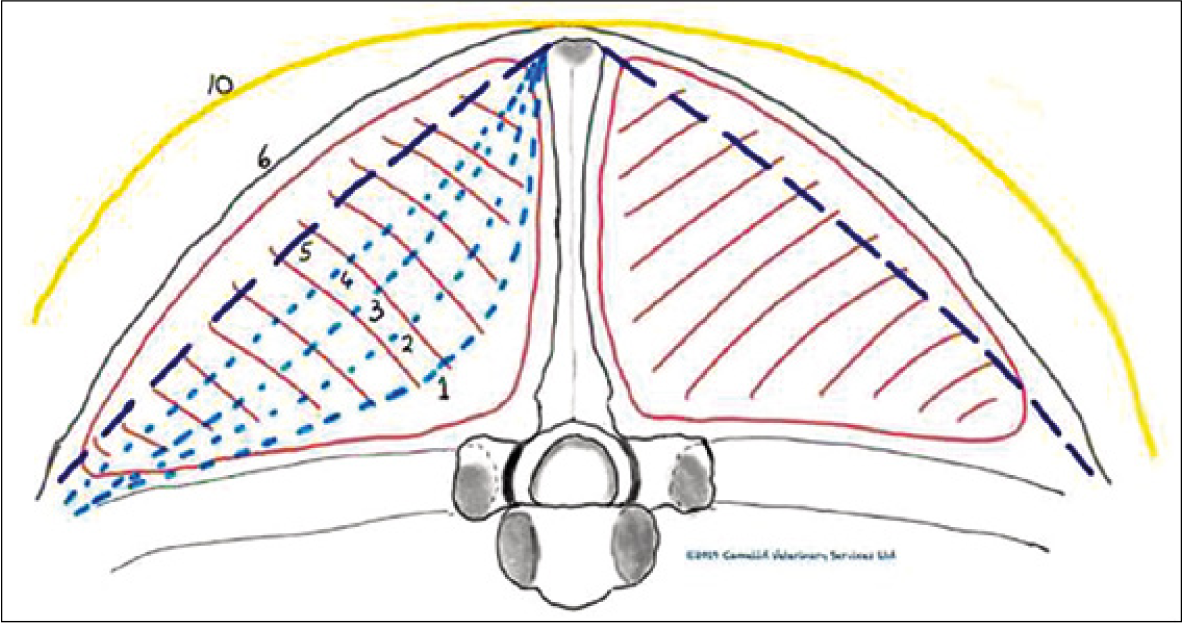
Figure 6. Alpaca body condition score on a scale of 1 to 10. The diagram shows a cross-section of the spine, muscle layer and fat tissue under the skin (created by Claire Whitehead DVM, Camelid Veterinary Services UK)
Plants that are dangerous to alpacas
The list of plants poisonous to alpacas is quite long. The authors of the text focused on the most important species,
commonly found in Polish gardens and meadows. Among the species whose entire plant is poisonous are: lily of the valley (Convalaria majalis), marsh marigold (Caltha palustris), sharp buttercup (Ranunculus acris), common yew (Taxus baccata), ivy (Hadera), Virginia creeper (Parthenocissus), all varieties of thuja (Thuja ssp.), most varieties of juniper (Juniperus ssp.). Consuming the flower of the field poppy (Papaver rhoeas) can cause slowed breathing, circulatory disorders, and even death. Gastrointestinal symptoms, such as vomiting and abdominal pain, may occur after eating honeysuckle (Lonicera), holly (Ilex), and hydrangea (Hydragea) flowers. Also poisonous are snowberry (Symphoricarpos), European spindle (Euonymus europaeus), and Japanese arborvitae (Thujopsis dolabrata).
Commonly found in pastures, clover (Trifolium ssp.) consumed in large quantities causes flatulence in alpacas. Cut hellebore (Helleborus niger) and foxglove (Digitalis purpurea) cause vasodilation with symptoms of shock. Euphorbia ssp. irritates the oral mucosa. Oak acorns (Quercus spp.), which alpacas love, can cause intestinal problems and constipation. Similar symptoms can be caused by eating Scots pine needles (Pinus ssp.) and large amounts of chickweed (Stellaria media).
Plants that cause diarrhea and gastric problems include cut boxwood (Buxus sempervirens) twigs and leaves, large amounts of field mustard (Sinapis arvensis), avocado peel (Persea americana), daffodil bulbs (Narcissus ssp.), wild elderberry (Sambucus ebulus), and autumn crocus (Colchicum autumnale). Flax (Linum ssp.) and potato (Solanum tuberosum) eaten in large quantities also have a laxative effect.
Plants that cause symptoms in the nervous system include: common bracken fern (Pteridium aquilinum), lupin pods (Lupinus ssp.), male fern roots (Dryopteris filix-mas), and horsetail (Equisetum ssp.) consumed in large quantities. Neurological symptoms may also be observed after eating monkshood (Aconitum napellus), poisonous hemlock (Cicuta virosa), common bleak (Aethusa cynapium), and ornamental morning glory (Ipomea muelleri) seeds. Irritation of the larynx and mouth may occur after eating calla lily (Zantedeschia aethiopica), but symptoms quickly subside. Hematuria may be caused by plants from the Brassicaceae family: common cabbage, rapeseed, radish.
In our latitude, there are plant species whose consumption is particularly dangerous for alpacas and requires specialist treatment. Cyanogenic glycosides can be found in the fruit of stone fruit trees, such as apricot (Prunus armeniaca), cherry (Cerasus Mill.), plum (Prunus domestica L. ssp.), peach (Prunus persica L. Batsch) and quince (Cydonia oblonga Mill.), as well as in a plant called sea squirt (Triglochin maritima), which occurs mainly on the coast and in the centre of the lowlands. Plants containing hyoscyamine, atropine or solanine include: black nightshade (Solanum nigrum), belladonna (Atropa belladonna) and black henbane (Hyoscyamus niger). The most poisonous of these plants are their seeds and roots. This group also includes the highly poisonous Datura stramonium and Solanum dulcamara. Among the plants containing nitrogen compounds is corn (Zea mays). Its taste means that it can be easily eaten in excess, as can milk thistle (Sylibium marianum). Among the plants that are dangerous to alpacas are those that cause inflammation of the gastric mucosa, manifested by excessive salivation and vomiting. These symptoms are caused by eating rhododendron (Rhododendron ssp.), common oleander (Nerium oleander), viburnum (Viburnum), and Daphne mezereum. Liver poisoning can be caused by algae (Microcistis spp., Anabena spp., Aphanizodemon spp.), common galega (Galega officinalis), and St. John’s wort (Hypericum perforatum). St. John’s wort also reduces the value of hay.
It is worth noting that some plants, although not toxic, can have an adverse effect in other ways. They can change the taste of the milk, which becomes unpalatable and sometimes toxic to the cria. These plants include: sorrel, garlic, sedges and horsetails. Plants can have shoots, fruits or seeds covered with thorns or various types of hairs that get entangled in the animal’s fleece, reducing its value. These plants can also hurt alpacas, being an indirect cause of infection. These include: thistle, thistle, blackberry, blackthorn, roses, alder and holly.
A very dangerous place for alpacas is undoubtedly the garden. According to data collected from Polish breeders, the most common fatal falls are recorded after eating cherry laurel (Prunus laurocerasus). Rhododendron and black locust (Robinia pseudoacacia) are less toxic, but also very poisonous.
Symptoms of poisoning can vary greatly depending on the type of toxins the plant contains. Recognizing them and linking them to the plant that is causing the problem can be crucial to saving the animal. Knowing the plant is essential to making the right decision about the type of treatment.
Summary
Alpaca breeding can be a business. When choosing this type of business, you should consider how much profit you want to make from breeding. Will the animals be treated as a source of income or a hobby? Alpacas live for over 20 years, and their reproductive life is also long – in this way breeding becomes long-term.
According to Polish regulations, alpacas do not have the status of farm animals, and therefore no additional permits or registration are required when running a herd. However, if you have a herd, you should report it to the appropriate district veterinarian.
Alpacas are herd animals, being in a group gives them a fundamental sense of security. Alone alpacas live in constant stress, which can lead to serious illness or even death.
Alpacas are grazing animals. They come from areas with a poor food supply, so their digestive and metabolic systems are evolutionarily adapted to a diet poor in nutrients but rich in bulk. 80-90% of alpacas’ diet is bulk feed, i.e. hay and grass. It is quite difficult to create one ideal recipe for a good feeding program, because a lot depends on the conditions on a given farm, on the quality of the soil, pasture and the quality of the hay. The health of alpacas and the quality of their fleece depend to a large extent on the way they are fed.
We invite you to read the entire original Polish article:


